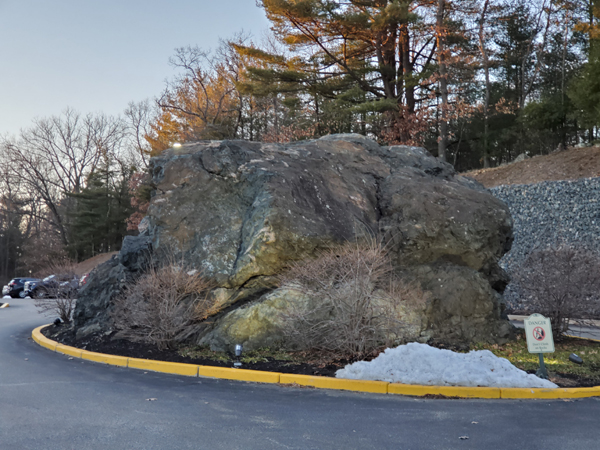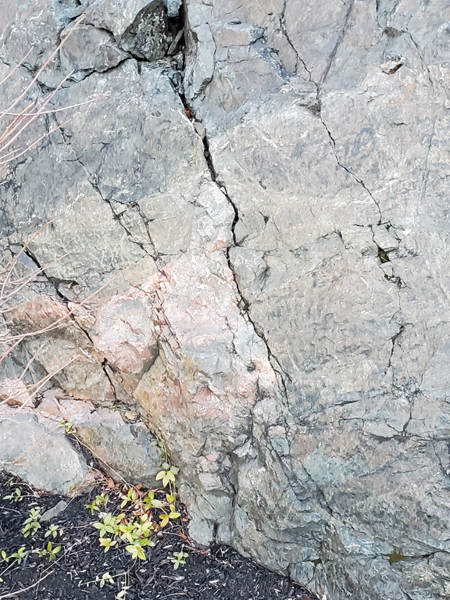Elements Earth Cache
The Bloody Bluff Fault is famous for a bloody battle during the Revolutionary War. Less famous, but certainly no less important, is the "Bloody Bluff Fault". This fault was one of many faults along the boundary between the "microcontinents" Avalon and Nashoba. This fault was active around 300 million years ago. A tiny bit of this fault can be seen at this location from the Battle Trail. Do not climb on the rocks/bluff. Wpt01.
In front of the Element Hotel, there is an outcropping of rock from this time period that has been exposed by the parking lot excavation. Here we can see evidence of the intense heat that was created during the plate collision. Normally strong and hard stone has been crystallized and become brittle.

Element Rock, Lexington, MA
“A key part of understanding Massachusetts geologic history is understanding the process accretion of several terranes onto the existing continent of Laurentia (what we call now North America). The easternmost of these terranes is Avalonia (in which the "Boston Basin" sits). Further west is the terrane of Nashoba”.[1]
The Bloody Fault marks the boundary between these two terranes. It can be seen in the outcropping.
Another fascinating feature, which can be seen from the outcropping in the Element Hotel parking lot, are exposed "mylonites". “Mylonite is a fine-grained, compact metamorphic rock produced by dynamic recrystallization of the constituent minerals resulting in a reduction of the grain size of the rock. Mylonites can have many different mineralogical compositions; it is a classification based on the textural appearance of the rock”.[2]

What do the cracks in this once strong granite rock tell us about what happened here?
“Mylonites are ductilely deformed rocks formed by the accumulation of large shear strain, in ductile fault zones. There are many different views on the formation of mylonites, but it is generally agreed that crystal-plastic deformation must have occurred, and that fracturing and cataclastic flow are secondary processes in the formation of mylonites. Mechanical abrasion of grains by milling does not occur, although this was originally thought to be the process that formed mylonites, which were named from the Greek μύλος mylos, meaning mill.[3] Mylonites form at depths of no less than 4 km”.[4]
There are many different mechanisms that accommodate crystal-plastic deformation. In crustal rocks the most important processes are dislocation creep and diffusion creep. Dislocation generation acts to increase the internal energy of crystals. This effect is compensated through grain-boundary-migration recrystallization which reduces the internal energy by increasing the grain boundary area and reducing the grain volume, storing energy at the mineral grain surface. This process tends to organize dislocations into subgrain boundaries. As more dislocations are added to subgrain boundaries, the misorientation across that subgrain boundary will increase until the boundary becomes a high-angle boundary and the subgrain effectively becomes a new grain. This process, sometimes referred to as subgrain rotation recrystallization,[5] acts to reduce the mean grain size. Volume and grain-boundary diffusion, the critical mechanisms in diffusion creep, become important at high temperatures and small grain sizes. Thus, some researchers have argued that as mylonites are formed by dislocation creep and dynamic recrystallization, a transition to diffusion creep can occur once the grain size is reduced sufficiently.
Mylonites generally develop in ductile shear zones where high rates of strain are focused. They are the deep crustal counterparts to cataclastic brittle faults that create fault breccias.[6]
These are highly deformed metamorphic rock caused by tectonic plate movements. The movement occurs deep in the crust where the rock is more ductile and less brittle, so the rock gets stretched, pulled and twisted, etc. The extent of shearing is less than you would see from plate movement in cooler, more brittle rocks closer to the earth's surface.
“The mylonites in this area (known as the Burlington Mylonite Zone) mostly occurred in two distinct time periods. The first occurred during Precambrian times as Avalonia was splitting away from Gondwana (around 600 million years ago). The second occurred in Silurian times (443-417 million years ago), as the continental margin of Avalonia was being subducted under Nashoba”.[1]
You can see rocks that were once basalt but has now been metamorphosed. Note that basalt is usually a uniformly dark color, and yet the basalt in this picture has many light-colored, twisted veins running through it. This is evidence of metamorphism.
At the top of the outcrop we see intensely metamorphosed amphibolite. This is likely an extension of the amphibolite in the previous pictures. Note the light-colored rock on the bottom. Samples of this rock show evidence of metamorphism, such as the fact that this once hard igneous rock is brittle and easy to break in layers (this is called foliation).
Logging Requirements:
- Can you describe what kind of process might cause solid rock to change like this?
- What process has caused the rock outcropping to become brittle?
- Do you think this is the same rock - granite? Why or why not?
- What evidence do you see that the rocks went through this stretching and pulling?
- What evidence do you see that the metamorphism happened under high temperature?
- Looking at Element Rock carefully, located the section that has a lot of stone shards. Why are they here and what color are they?
- Take a photo of yourself (or a personal object) in front of the rock formation. (Please note this is a mandatory requirement and is permitted under the update to the earthcaching guidelines of 10 JUL 19)
Message the answers to me via my geocaching.com profile. You may log this Earth Cache immediately, but I will delete logs if I do not have a message from you with correct answers. If there are any incorrect answers, I’ll message back to you for clarification. Remember, Earth Caches are meant to be visited.
Other pictures are welcome...if they don't give away the answers. :)
This Earth Cache has been made possible by the generous permission granted by the Element Hotel. Please be respectful of their guests and do not climb on the rocks.
References
[1] Boston Rocks: Deb Allen and Mark Goldner, Brookline Public Schools
[2] Wikipedia: Mylonite
[3] Lapworth, C. (1885). "The highland controversy in British geology; its causes, course and consequence". Nature. 32: 558–559.
[4] Mylone, alexstreckeisen.it
[5] Urai J.L.; Means W.D.; Lister G.S. "Dynamic recrystallization of minerals". Retrieved 9 July 2016.